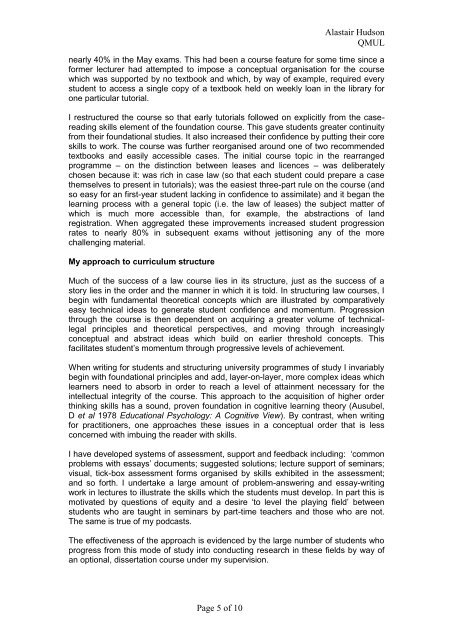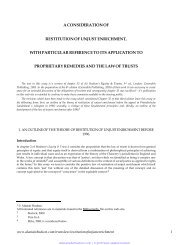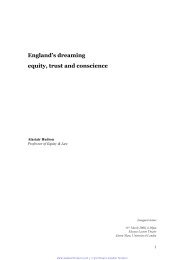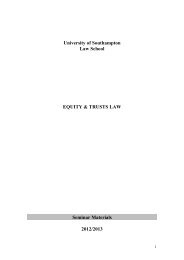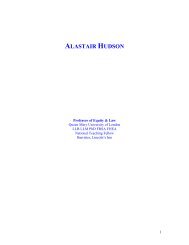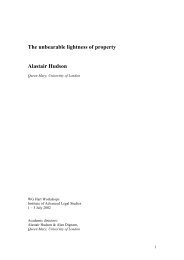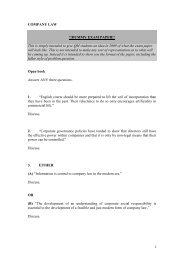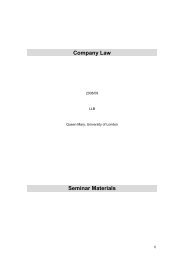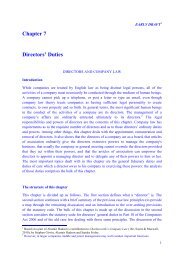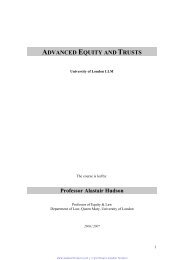The underpinning of my philosophy of teaching was best expressed ...
The underpinning of my philosophy of teaching was best expressed ...
The underpinning of my philosophy of teaching was best expressed ...
Create successful ePaper yourself
Turn your PDF publications into a flip-book with our unique Google optimized e-Paper software.
Alastair HudsonQMULnearly 40% in the May exams. This had been a course feature for some time since aformer lecturer had attempted to impose a conceptual organisation for the coursewhich <strong>was</strong> supported by no textbook and which, by way <strong>of</strong> example, required everystudent to access a single copy <strong>of</strong> a textbook held on weekly loan in the library forone particular tutorial.I restructured the course so that early tutorials followed on explicitly from the casereadingskills element <strong>of</strong> the foundation course. This gave students greater continuityfrom their foundational studies. It also increased their confidence by putting their coreskills to work. <strong>The</strong> course <strong>was</strong> further reorganised around one <strong>of</strong> two recommendedtextbooks and easily accessible cases. <strong>The</strong> initial course topic in the rearrangedprogramme – on the distinction between leases and licences – <strong>was</strong> deliberatelychosen because it: <strong>was</strong> rich in case law (so that each student could prepare a casethemselves to present in tutorials); <strong>was</strong> the easiest three-part rule on the course (andso easy for an first-year student lacking in confidence to assimilate) and it began thelearning process with a general topic (i.e. the law <strong>of</strong> leases) the subject matter <strong>of</strong>which is much more accessible than, for example, the abstractions <strong>of</strong> landregistration. When aggregated these improvements increased student progressionrates to nearly 80% in subsequent exams without jettisoning any <strong>of</strong> the morechallenging material.My approach to curriculum structureMuch <strong>of</strong> the success <strong>of</strong> a law course lies in its structure, just as the success <strong>of</strong> astory lies in the order and the manner in which it is told. In structuring law courses, Ibegin with fundamental theoretical concepts which are illustrated by comparativelyeasy technical ideas to generate student confidence and momentum. Progressionthrough the course is then dependent on acquiring a greater volume <strong>of</strong> technicallegalprinciples and theoretical perspectives, and moving through increasinglyconceptual and abstract ideas which build on earlier threshold concepts. Thisfacilitates student’s momentum through progressive levels <strong>of</strong> achievement.When writing for students and structuring university programmes <strong>of</strong> study I invariablybegin with foundational principles and add, layer-on-layer, more complex ideas whichlearners need to absorb in order to reach a level <strong>of</strong> attainment necessary for theintellectual integrity <strong>of</strong> the course. This approach to the acquisition <strong>of</strong> higher orderthinking skills has a sound, proven foundation in cognitive learning theory (Ausubel,D et al 1978 Educational Psychology: A Cognitive View). By contrast, when writingfor practitioners, one approaches these issues in a conceptual order that is lessconcerned with imbuing the reader with skills.I have developed systems <strong>of</strong> assessment, support and feedback including: ‘commonproblems with essays’ documents; suggested solutions; lecture support <strong>of</strong> seminars;visual, tick-box assessment forms organised by skills exhibited in the assessment;and so forth. I undertake a large amount <strong>of</strong> problem-answering and essay-writingwork in lectures to illustrate the skills which the students must develop. In part this ismotivated by questions <strong>of</strong> equity and a desire ‘to level the playing field’ betweenstudents who are taught in seminars by part-time teachers and those who are not.<strong>The</strong> same is true <strong>of</strong> <strong>my</strong> podcasts.<strong>The</strong> effectiveness <strong>of</strong> the approach is evidenced by the large number <strong>of</strong> students whoprogress from this mode <strong>of</strong> study into conducting research in these fields by way <strong>of</strong>an optional, dissertation course under <strong>my</strong> supervision.Page 5 <strong>of</strong> 10


